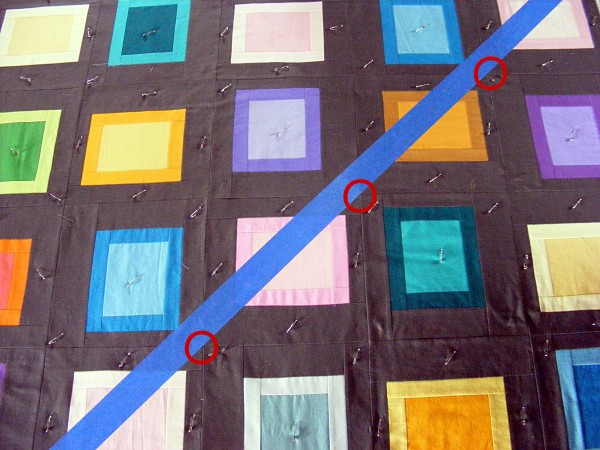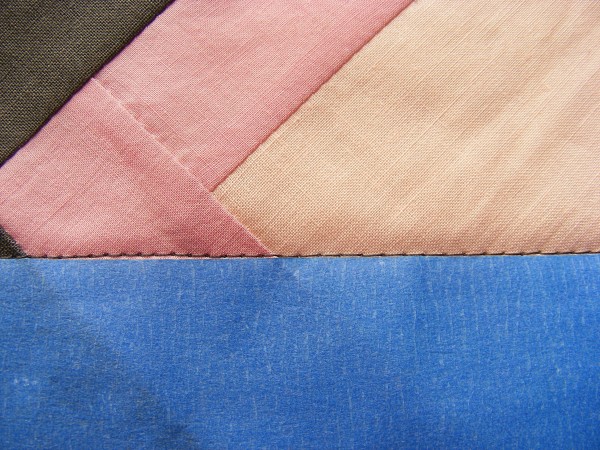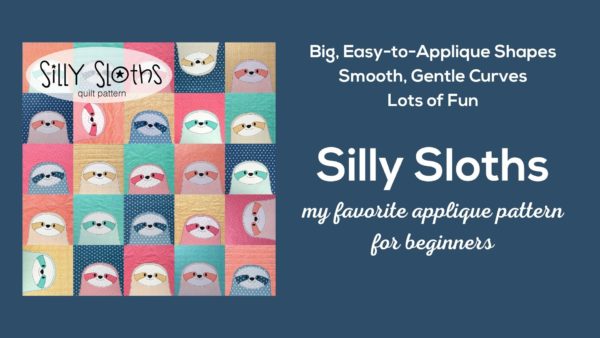I know. You look at that mass of quilt and you look at the space under the arm of your sewing machine and you think, “No way!”
You’d be wrong.
You can totally quilt a big quilt on a regular sewing machine.
I’ve actually quilted king size quilts on my machine – though in this video I’m demonstrating on a twin size.
First, watch this video showing the basics of machine quilting. That video uses a little doll quilt as a sample – easy to see and get a feel for the process – but it doesn’t answer the question you really have about doing the same thing with a bed quilt. That’s what I tackle in this video. So watch it now.
Important! See that little black bit behind the presser foot on my machine? That’s my walking foot. I forgot to mention it in the video – but it’s pretty critical. You really can’t machine quilt without one – it’ll end up all puckery and you’ll be sad. 🙁
And what if you want to quilt lines that don’t follow the seams of the quilt?
Tape – my friends. Painters tape.
On the Flower Beds Quilt I wanted to quilt a diagonal grid over the whole surface. I laid down a strip of masking tape to guide my first line. See how the edge of the tape intersects the corners of the blocks? (That’s what those red circles are showing.) That helps me get a perfectly straight line. Quilt right along the edge of the tape.
Then remove the tape.
You only need to do this for the first row of stitching. After that each row serves as the guide for the next.
I usually just eyeball the distance between rows, but in case you want a little more precision – check out this video showing you a nifty little gizmo to help you stitch perfectly parallel lines.

Here are all my posts about layering and basting your quilt, and the final round of quilting.
- How to Layer and Baste a Quilt Sandwich
- How to Machine Quilt
- My Favorite Tip for Machine Quilting without Swearing
- How to Quilt a Big Quilt on a Standard Sewing Machine
- What Does It Mean to Start Quilting in the Middle and Work Your Way Out?
- How to Quilt Perfectly Parallel Lines
- Tips for Quilting a Cuddle Fleece Back
- Quilting with Decorative Stitching
Here are all my posts about hand quilting and Big Stitch quilting. I don’t use these techniques with fusible applique or Quilt As You Go, but I LOVE using Big Stitch Quilting with my cheater fabric.
- How to Tie a Knot
- Hand Quilting Basics – traditional hand quilting
- Hand Quilting without Marking
- Big Stitch Quilting
- How to Quilt All the Way to the Edge
Finished with this topic?
Return to the Let’s Make a Quilt main Table of Contents.
Move on to the lessons about binding and finishing your quilt.
Happy quilting!










What an awesome video! You are a good teacher. I was wondering what quilt pattern you are using in the video? It is super cute!
Thanks – it’s just a scrap quilt with no pattern. I think I might put one together though – and release it as a free pattern later this year.
I just signed up for the newsletter and am looking through your site for the first time. This is the first video I watched and I wanted to let you know how impressed I am and how much I am looking forward to learning from your videos and instructions. What a great resource!! Thank you!
I’m glad it was helpful! 🙂
Hi Wendi–
Love the clean layout of your site and your very helpful videos. Thank you! Two questions for you: I’m about to do my first machine quilting, and I’m using a great, but plain, 20 year old Pfaff machine. I’m going to stuff and fluff. You’ve inspired me!
First question: Do I need to turn the quilt each time I sew a line of quilting? (So I would sew bottom to top, flip it around, and then sew top to bottom–I’m doing a queen size quilt, which is why I’m hesitating on doing this.) Some women in my local quilt shop insisted I do this. Others rolled their eyes and shrugged their shoulders. What is your opinion?
Second question: when using a walking foot, do I need to lower the feed dogs on my machine?
Third question (sorry–just thought of another): I want to do a simple grid. Each block is 9″x9″. I was going to divide each block in half, sewing lines at approximately 4.5 inches. I was thinking about using your painting tape idea to get the correct distance. Do you think that 4.5″ is too far apart (the same WatQS–women at the quilt store insisted I do not quilt further apart than 4″)?
Thanks for any thoughts/suggestions!
Melanie
1. I don’t turn my quilt at the end of each run – I just keep going in whatever direction puts as little quilt under the arm of the machine as possible. Some people find they get some distortion that way, and turning it minimizes it. That makes sense – but I’ve never had a problem with it so I don’t do it.
2. Don’t lower the feed dogs when you use a walking foot! The walking foot is like adding feed dogs to the top of your quilt – you want the two “grabbers” to work together to feed the top and bottom layers through at the same rate.
3. How close you quilt depends on what brand of batting you’re using. Look on the package – it should say somewhere. Some battings require quilting every two inches, some every four. My favorite (Warm & Natural) can be quilted every 10 inches – though I often quilt closer than that because I like the crinkly look that you get from dense quilting.
Hope these help!
Hi,I have half the throat space as urs. can i still quilt a big quilt. I have the top ready. Im hesitant to start.
I used to have a Kenmore that had a smaller throat space and I was able to quilt big quilts on it – just stick to straight lines if possible, or VERY gentle curves. That will make things a LOT easier.
You are amazing! Your videos make quilting fun and easy. They give me confidence to try it.. Thank you!
Thank you for the wonderful video – It gave me the confidence that I can make my first quilt. (A scrappy trip). I am so excited to get started!
Wendy,
I have enjoyed making the dinosaur quilt top as QAYG and now I’m almost ready to machine quilt the entire sandwich together. Thank you for the wonderful instructional videos clearly showing each step along the way. QAYG takes so much stress out of the process! Jacob is eager for his dinosaur birthday quilt to get finished!
Thank you, for this video. I’m a beginner and was searching for a video of what to do next after Sandwiching the layers. Been searching quite awhile. Thankfully, I ran into yours. Thank you so much!
This post and the video were super helpful to me, thank you so much for the clear instructions!
Hi Wendy, In one of your videos you machine stitched from the middle to the end, and then said to flip the quilt around and start in the middle to the end again. Is that okay, or should you start on the same side and work to the other end?
Here’s the link to that video so you can see what I mean. https://www.shinyhappyworld.com/2017/03/quilting-center-edges-video-tutorial.html
Thank you for such a helpful video! This is exactly what I was looking for!
I used your stuff and fluff advice for my first quilt and it turned out great. I just kept repeating, Stuff and Fluff, Stuff and Fluff, as I worked! 😉 That quilt just involved straight lines, as you show in the video. But now I’m about to quilt something that needs diamond patterns throughout. It’s a Crossed Canoes block and I’ve decided to do concentric diamonds (if that makes sense) in the large diamond sections of the quilt. I realize this means I’ll need to stop and turn to make my shapes. Of course I’ll turn with the needle down. My question is, will Stuff and Fluff still work for me?!
Thank you for the video. You enabled me to successfully quilt my first project. Hoping all turns out well on this second one.
It will, but it’s going to take a LOT longer because you’ll need to reposition the mass of your quilt after every turn. Take it slowly, and take plenty of breaks. It’s not going to be fun. 🙁
Pingback: Quilting with Decorative Stitches - Shiny Happy World
Thanks this helps me. I can’t afford to buy a quilting machine now I n
Know I can do it with my regular machine.